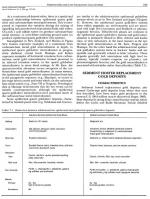Sediment hosted replacement gold deposit
Sediment hosted replacement gold deposits, also termed Carlin-type gold deposits from where they were first described, have been major gold producers in the western U.S. (98.8 million ounces discovered; Singer, 1993). Most deposits lie along deep crustal fracture systems which define the Carlin and Battle Mountain Trends (Madrid and Roberts, 1990). Significant new discoveries within the Carlin Trend include the Betze-Post and Meikle ore systems (Bettles and Lauha, 1991), with production of 7.1 million ounces andreserves of 28 million ounces of gold at the end of 1994 (Volk et al, 1995). Reviews of this style of gold mineralization by Bagby and Berger (1985), Sawkins (1984), Sillitoe and Bonham (1990), Berger and Bagby (1991), and Kuehn and Rose (1995) present geological models for this deposit type. Critical in the development of these models has been the recognition of similar deposit types in other settings (e.g., Bau, Sarawak; Wolfenden, 1965; Sillitoe and Bonham, 1990: China; Cunningham et al., 1988: Melco and Barney's Canyon deposits, Bingham District, U.S.; Babcock et al., 1992: Mesel, North Sulawesi; Indonesia; Turner et al., 1994; Garwin et al., 1995: and elsewhere in the eastern and western Pacific Rim, G. Corbett and T. Leach, unpub. data; Gemuts et al, 1996: Fig. S.l).
Aspects of sediment hosted replacement gold deposits discussed more fully in the above reviews include:
• Host rocks, described as silty carbonaceous carbonate, carbonate-bearing shale, dolomite and limestone.
• Structural settings, characterized by extension, including normal faults, common doming, and local caps of impermeable units (Berger and Bagby, 1991). Back-arc settings appear to represent conducive environments.
• Metal association of high fineness gold, and enrichments in As, Hg, Sb, Ba, and Tl. Some examples (e.g., Bau, Sillitoe, and Bonham, 1990) are enriched in base metals. Many are metallurgically difficult because of arsenic in the ores.
• Magmatic association is commonly represented by felsic dikes which are indicative of the inferred distal relationship of gold mineralization to intrusion source rocks (Sillitoe and Bonham, 1990; Berger and Bagby, 1991).
• Depth of formation, which is inferred to be well below epithermal environments (Sillitoe and Bonham, 1990; Kuehen and Rose, 1995).
• Mixing of volatile-rich fluids derived from considerable depth with meteoric fluids is inferred as a mechanism of gold deposition by Kuehen and Rose (1995).




